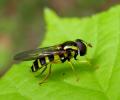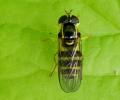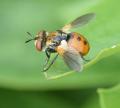|
Parasitic wasp
|
|
| Smoggycb |
Posted on 07-12-2009 11:06
|
|
Member Location: Posts: 350 Joined: 19.05.07 |
Sorry for the poor quality of the images. From a house on the south coast of England in early november (found dead) |
|
|
|
| Smoggycb |
Posted on 07-12-2009 11:07
|
|
Member Location: Posts: 350 Joined: 19.05.07 |
and a second image |
|
|
|
| Gerard Pennards |
Posted on 07-12-2009 11:08
|
|
Member Location: Posts: 1914 Joined: 07.06.04 |
Ichneumonidae, looks like subfamily Pimplinae.. Greetings Greetings, Gerard Pennards |
|
|
|
| Smoggycb |
Posted on 07-12-2009 14:30
|
|
Member Location: Posts: 350 Joined: 19.05.07 |
Thanks Gerard |
|
|
|
| ChrisR |
Posted on 07-12-2009 16:49
|
|
Administrator Location: Posts: 7699 Joined: 12.07.04 |
If you send it over I can give you a name for it - the RES pimpline key is pretty easy to use 
Manager of the UK Species Inventory in the Angela Marmont Centre for UK Biodiversity at the Natural History Museum, London. |
|
|
|
| cthirion |
Posted on 07-12-2009 18:04
|
|
Member Location: Posts: 901 Joined: 13.08.04 |
There are optimists !
cthirion |
|
|
|
| ChrisR |
Posted on 07-12-2009 19:46
|
|
Administrator Location: Posts: 7699 Joined: 12.07.04 |
LOL, the key to British Pimplinae is very good - I have used it many times here and Mark Shaw has recently released updates to it... so I have reasonable confidence for UK material 
Manager of the UK Species Inventory in the Angela Marmont Centre for UK Biodiversity at the Natural History Museum, London. |
|
|
|
| cthirion |
Posted on 07-12-2009 22:28
|
|
Member Location: Posts: 901 Joined: 13.08.04 |
Yes....for UK material!
cthirion |
|
|
|
| Smoggycb |
Posted on 08-12-2009 10:25
|
|
Member Location: Posts: 350 Joined: 19.05.07 |
Thanks for your contributions. Chris, if I think on I will bring it to the tachinid workshop in February. |
|
|
|
| Pierre-Nicolas Libert |
Posted on 08-12-2009 10:33
|
|
Member Location: Posts: 82 Joined: 31.08.04 |
What is the size?
Pierre-Nicolas |
|
|
|
| Smoggycb |
Posted on 08-12-2009 11:20
|
|
Member Location: Posts: 350 Joined: 19.05.07 |
12mm from head to tip of abdomen, with another 3mm of ovipositor. |
|
|
|
| Pierre-Nicolas Libert |
Posted on 08-12-2009 14:33
|
|
Member Location: Posts: 82 Joined: 31.08.04 |
Before confirmation, could you make a picture of Tibia III or tell me if is it completely red.
Pierre-Nicolas |
|
|
|
| Smoggycb |
Posted on 08-12-2009 14:59
|
|
Member Location: Posts: 350 Joined: 19.05.07 |
Tibia III is completely red Pierre. |
|
|
|
| Pierre-Nicolas Libert |
Posted on 08-12-2009 16:09
|
|
Member Location: Posts: 82 Joined: 31.08.04 |
Then it is at 99,9% Pimpla rufipes.
Pierre-Nicolas |
|
|
|
| Smoggycb |
Posted on 08-12-2009 16:12
|
|
Member Location: Posts: 350 Joined: 19.05.07 |
Excellent! Thanks Pierre-Nicolas, more than I could have reasonably hoped for. |
|
|
|
| ChrisR |
Posted on 08-12-2009 18:43
|
|
Administrator Location: Posts: 7699 Joined: 12.07.04 |
That's a nice ID - can you bring it to the workshop anyway Chris? I'd like to run it through the British key and just make sure I get it out to that species - I don't think I have seen P.rufipes yet 
Manager of the UK Species Inventory in the Angela Marmont Centre for UK Biodiversity at the Natural History Museum, London. |
|
|
|
| Smoggycb |
Posted on 08-12-2009 19:30
|
|
Member Location: Posts: 350 Joined: 19.05.07 |
OK Chris, will do. |
|
|
|
| Pierre-Nicolas Libert |
Posted on 08-12-2009 23:30
|
|
Member Location: Posts: 82 Joined: 31.08.04 |
I'd like to run it through the British key In the British key, you'll find it under Pimpla hypochondriaca (now synonym of rufipes) I don't think I have seen P.rufipes yet You should it is one of the most common... good night Pierre-Nicolas |
|
|
|
| ChrisR |
Posted on 08-12-2009 23:52
|
|
Administrator Location: Posts: 7699 Joined: 12.07.04 |
Ahh, P.hypochondriaca sounds much more familiar  I probably just need to apply Marsh Shaw's updates to my copy and add-in some margin notes I probably just need to apply Marsh Shaw's updates to my copy and add-in some margin notes  Thanks for the clarification. Thanks for the clarification.
Manager of the UK Species Inventory in the Angela Marmont Centre for UK Biodiversity at the Natural History Museum, London. |
|
|
|
| Jump to Forum: |













